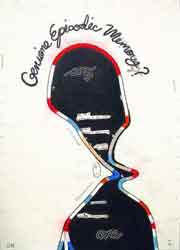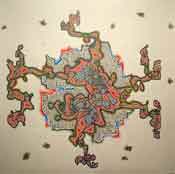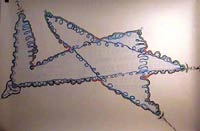|
John J. O'Connor, Schemes Out
by Gregory Montreuil
 |
False
Memory 1, 2001, above,
and Head Itch, below, show how O'Connor graphically depicts
systems and actions. |
In this mind-bending,
conceptually generated show of ten large-scale drawings, disparate
subjects are juxtaposed in surprising ways. O'Connor, inventing
comparisons and systems of relationship, mixes the scientific with
the absurd. Executed in graphite and colored pencil with a multitude
of notations, these works create a kind of brainy hopscotch. Puzzling
juxtapositions abound, with results that are original and surprising
through these investigations of obtuse relationships. Chance is
incorporated and honored, as O'Connor draws from the tradition of
the Dadaists, Duchamp and others. The implication holds the absurd
as a relevant option, giving the pieces in the show a nihilist edge.
By offering another point of view through his pseudoscientific approach,
Mr. O'Connor challenges the construct of reality.
The inner workings of
the mind and the external environment are often bridged by the
drawings through their systematic sensory notation. Each drawing
is used to illustrate a specific idea or relationship and have titles
like Head Itch, False Memory, and Scratch.
The titles give clues to the visually quirky and accomplished drawings.
Each work on paper comes with an accompanying text that explains
the origin of the ideas that are "graphically represented."
 Using
eccentric and arcane postulates, Recession (2002) explores
hair loss. “The subject of this drawing is the patterns, consequences
and irony of hair loss,” according to the artist's written
explanation. “It is something that affects me personally.”
The resulting drawing is a strange schematic of lines that form
a spaghetti-like, arched wig shape. Otherworldly and faceless, the
image is original and haunting. Using
eccentric and arcane postulates, Recession (2002) explores
hair loss. “The subject of this drawing is the patterns, consequences
and irony of hair loss,” according to the artist's written
explanation. “It is something that affects me personally.”
The resulting drawing is a strange schematic of lines that form
a spaghetti-like, arched wig shape. Otherworldly and faceless, the
image is original and haunting.
False Memory 1
(2001) is more psychedelic in feel. Dense and interwoven, it has
beautiful passages of shading and a multitude of numerical notations.
CWST (2002) explores body temperature and calories burned.
Another piece is an elaborate system to record itching and the conditions
surrounding its occurrence.
Ebbinghaus Map
(2002) uses the theories of a German scientist about memory and
its predictable rate of disappearance. O'Connor then invents an
elaborate system to test himself and the theory by recreating a
shape over and over with his eyes closed. The artist tests his memory
and ability with the resulting drawing acting as a record of his
fading memory.
 Earthquakes
and Wars (2002) compare the two named occurrences within the
confines of the United States and a specific time period. The resulting
rendering is a kind of warped rainbow flow chart with meticulously
noted times and dates and correspondence between these differing
and violent events. Several of the drawings are covered with notations
like measles, giving them an obsessive quality. The blank spaces
left around the perimeter of most of these pieces give some visual
relief to these dense works. Some drawings share a visual kinship
with Jonathan Lasker's work Earthquakes
and Wars (2002) compare the two named occurrences within the
confines of the United States and a specific time period. The resulting
rendering is a kind of warped rainbow flow chart with meticulously
noted times and dates and correspondence between these differing
and violent events. Several of the drawings are covered with notations
like measles, giving them an obsessive quality. The blank spaces
left around the perimeter of most of these pieces give some visual
relief to these dense works. Some drawings share a visual kinship
with Jonathan Lasker's work
Internal mapping, scientific
inquiry and its unpredictable conclusions inform this eccentric
exhibition .The pseudoscientific mixes with the absurd to form complex
thoughts represented through images. The impetuses come from O'Connor's
curious mind; from earthquakes to obesity genes to temperature prediction,
ideas are processed through intricately layered systems with the
resulting drawings acting as graphic representations of the ideas.
The drawings act as a form of internal cartography. Inventing comparisons
and systems of relationship, these works display a deep trust in
the futile. This exhibition shows an artist involved in challenging
himself and his viewers by creating ways to set into motion the
wonder of discovery and possibility.
—Gregory
Montreuil is a writer and artist living and working in New York
City
|

